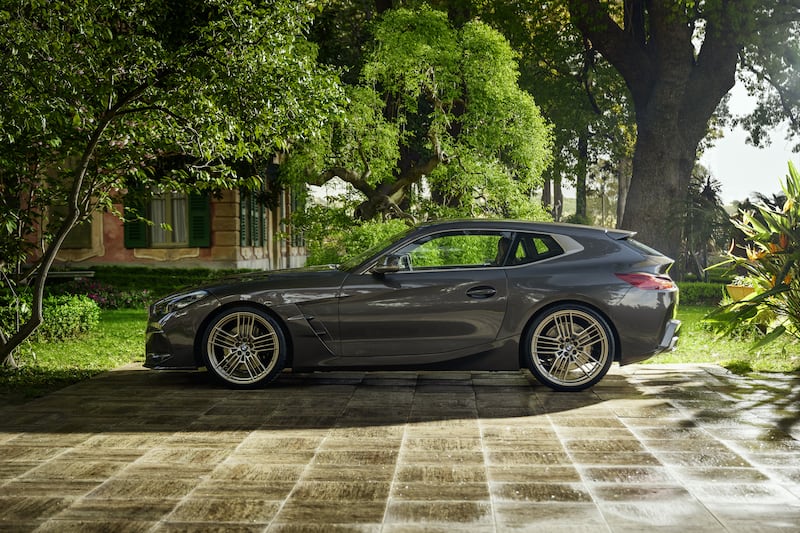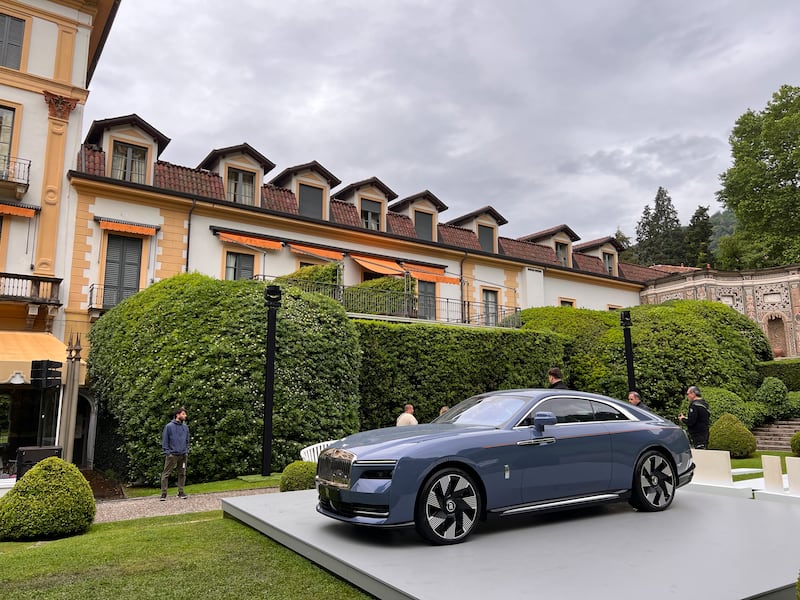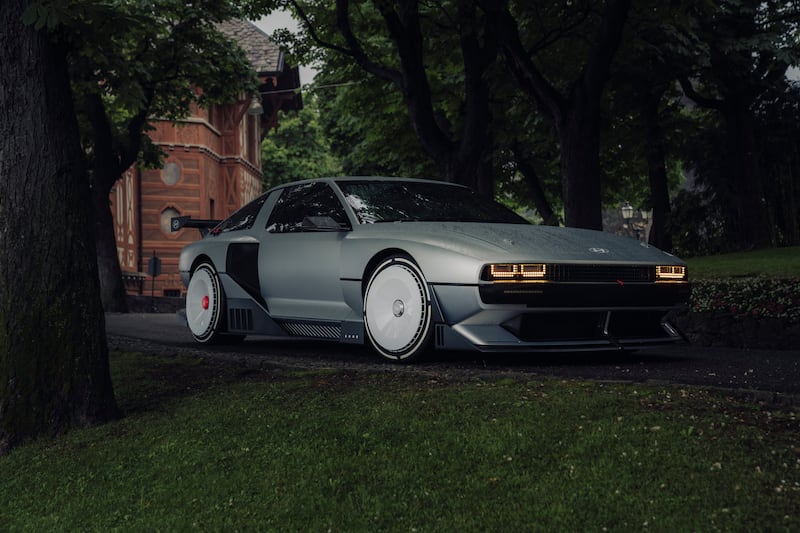Classic cars take centre stage at the Concorso D’Eleganza. It is of the most prestigious historic motoring events on the calendar: each year a handful of the most valuable and rarest cars in the world are invited to the grounds of the Villa D’Este – once a stately home, now a five-star hotel on the shores of Lake Como, just north of Milan – to parade and be judged. From a 1920s experimental Rolls-Royce that was the first Roller to hit 160km/h (100mph) to a near-as-dammit priceless Ferrari 250 GTO to race-winning Porsches, they all came in search of golden trophies and the kudos of the cognoscenti.
How much of this is all about billionaires having a series of competitions to see who has the largest motoring priapism is up for debate but, away from the classics, the Concorso is also an important modern-day motoring event. BMW is a major sponsor of it, and always brings along a new car or three to be admired by the crowds, and the people with the big chequebooks.
The event kicked off on a rainy, squally night, as BMW revealed for the first time its Concept Touring Coupe.

It’s based on the current Z4 two-seat sports car, but gets a totally new rear end that turns it into a spacious (albeit still two-seat) shooting brake estate. It’s entirely a throwback to the kind of luggage-friendly sports cars built back in the 1950s and 1960s, but one that has call-outs to the likes of the new XM hybrid SUV in the heavy trim around the rear side glass, and the turret-like shapes at the rear of the roof. The grey-blue-brown paintwork has been designed especially for the car, and is called Sparkling Lario.
RM Block
Inside, there is hand-made leather, finished in dark and light browns with braided sections at the edges of the cabin, made by Poltrona Frau – a famed Italian leather maker. In the back, there is a fitted set of soft leather and fabric weekend bags, made by the Schedoni leather workshop in Modena, the same Italian town in which Ferraris are made.
At first, all of the indications were that the car was strictly a one-off – a styling flight of fancy, albeit one that is drivable thanks to a production Z4 base and a fully functioning 340hp straight-six engine under that lengthy bonnet. However, as the weekend wore on, and the reaction to the car proved almost overwhelmingly positive, talk began to turn to the possibility of actually making a handful.
Adrian van Hooydonk, BMW’s head of design, did drop a crumb of possibility. “A collectible car has to have character, it doesn’t have to be perfect, in fact it almost has to have some quirk or imperfection. If you look back at our heritage at BMW, we’ve had Z3 coupes and Z4 coupes. One was a shooting brake, the Z3, and the other, the Z4, was a fastback,” Van Hooydonk told The Irish Times.
“Perhaps the fastback was more elegant, but it was the Z3 shooting brake that became the collectors’ item. That’s the car that people have grown more attached to, and that was the form we used to create the Touring Coupe. It’s a one-off for now, but we hope that one day we can have something new to contribute to the passion that people share here at the Concorso. If we, maybe, made 50 pieces, that could becoming something that would be rare and collectible, and strong in character. That’s what we try to do.”
[ Apple CarPlay, General Motors,and the battle for control in the front seatOpens in new window ]
BMW has form in this area, creating a 50-off run of its gorgeous CSL Coupe, based on the rather less gorgeous M4 Competition, so there is a sliver of a chance that the Touring Coupe could make production in some small way. It won’t be cheap, though – prices of over €300,000 for the car were being spoken of. In fairness, for the crowd at the Concorso, that’s chump change.
If you want to spend some real money, Rolls-Royce can accommodate your wishes. The super-luxury car firm – owned for some time now by BMW – had its first all-electric model, the Spectre, on show. It’s expected to go into production later this year.
The battery will have a usable capacity of at least 100kWh, giving the Spectre a range of more than 510km. Not huge, perhaps (100km less than you get from a Hyundai Ioniq 6, let’s not forget), but probably sufficient for most Rolls-Royce owners, who are more likely to take the Gulfstream or the Learjet for longer journeys…
With two electric motors, the Spectre will have 585hp, but, according to Rhodri Good, project manager for the Spectre, the point is not to snap your neck with acceleration. “It’s a true Rolls-Royce, not only in how it looks, but also in its character. We’ve got a lot of traits from the V12-engined cars in here. So, of course, the acceleration is good. It’s in line with the V12 cars, but we haven’t given in to the gimmicks that some people might associate with electric cars.”

Rolls-Royce’s chief executive officer, Torsten Müller-Ötvös, agrees. “I can’t comment on what other brands will do, of course,” Müller-Ötvös tells The Irish Times. “For us, it’s the ideal way to go when it comes to alternative propulsion because electric fits the brand. The silence, the torque, which is important for us to create that ‘waftability’ that comes with a Rolls-Royce. We are not defined by roaring exhausts and loud engines – actually the opposite.”
Unlike rival brands such as Ferrari and Porsche, who have lobbied hard to have e-fuels allowed for in future legislation, Rolls-Royce has committed to being a fully electric brand by the end of 2030. That will not mean creating electric versions of the current line-up of the Ghost, Phantom and Cullinan SUV (Müller-Ötvös says that to do that would be “easy, but a little bit boring”), and so entirely new models, based around the aluminium “Architecture of Luxury” platform will be designed to make the most of electric power.
However, there’s a major elephant in the room – weight. Rolls-Royces are not exactly known for being exceptionally light, but the Spectre tips the scales at only a fraction less than three tonnes. That’s a whopping weight for a car claiming to be a coupe, but which is actually longer than a Range Rover.
Müller-Ötvös defends the Spectre’s avoirdupois, though. “Just to be crystal clear, we are not saying – bingo – this is our sustainability job done. This is a long-term journey. When it comes to sustainability, we also look at how we build our cars, the materials we use, the whole CO2 footprint.”
More than justifying the Spectre’s hefty weight, Müller-Ötvös essentially blames the legislation being brought forward which is all but antagonistic to the heft of the electric vehicles it’s generating. “Combustion engines will more and more see tough regulations, including many that will say you are no longer allowed to register cars, or you are no longer allowed to go into city centres. And that would harm our brand in a massive way. Our clients live in the world’s big cities, and they use our products to commute into and out of those cities. So, for us, going electric is not all about the ecological side, that was not the intention. It was to keep the Rolls-Royce brand relevant both for our existing clients, and for a whole new breed of client whom we simply haven’t seen before.”
[ BMW 5 Series goes all-electric with i5Opens in new window ]
If the Spectre’s weight, and its likely €700,000 price tag, are all a bit too much for you, how about something rather more affordable? And Korean? BMW might sponsor the Concorso, but it’s not above letting another manufacturer have a slice of the limelight.
Presented to the public on the fringes of the Concorso D’Eleganza, the reborn Hyundai Pony Concept Coupe is a precise and perfect recreation of the original, by the man who originally designed it. The great (and we don’t use the word lightly) Giorgetto Giugiaro was asked to create a Hyundai concept for the 1974 Turin Motor Show. Giugiaro created the Pony Concept Coupe, a tightly surfaced, needle-nosed car that perfectly reflects Giugiaro’s obsession with neat, straight lines on a car (see also: Lotus Esprit S1, Fiat Panda, Mk1 VW Golf).
Sadly, the Pony Concept Coupe never made it to production. Hyundai, at the time, was far more focused on building cars that people could afford and couldn’t spare the development cash to get a low-volume coupe into production, no matter how gorgeous it was. Even more sadly, the car was not added to a museum collection, but was simply abandoned in a corner. At some point, it must have been scrapped because Hyundai was later able to find no trace of it.
Thankfully, the Pony Concept Coupe now lives again, thanks to the work of Hyundai and Giorgetto Giugiaro himself. With the 50th birthday of both the concept and the original production coupe approaching, Hyundai asked Giugiaro – and GFG Style, the design house that he runs with his son Fabrizio – to remake the original in painstaking detail. In fact, there’s only one detail which is not quite as it originally was: the Pony Concept Coupe now rides on 15-inch wheels, rather than the 1974-spec 14-inch items, simply because the correct tyres were no longer available.

“Hyundai approached us to start a complete redesign of a model, without much experience. I was sceptical at first because I didn’t know Hyundai Motor at that time” said Giorgetto Giugiaro. “We were all impressed by the passion and commitment of the Hyundai engineers. They were sharp, curious, open and extremely eager to learn. They immediately embraced the working methods that were new to them. They sacrificed themselves to make a good impression – for company and their partners. I’m proud and honoured to witness how this company has evolved since we first met.”
So, why has Hyundai done this? A bit of corporate self-backslapping? A simple wish to see the company’s heritage rebuilt? Simply because it can now afford to do so? Probably all three, but there’s a fourth reason – Hyundai wants to become known as a style and design leader, moving away from its history as a maker of simple, affordable cars. Recent models such as the Ioniq 5 and Ioniq 6 have had distinct retro overtones – the 5 owes a clear debt to the original Pony and Pony Concept Coupe, while the 6 takes inspiration from 1960s Porsches and 1950s Tatras – and Hyundai wants to show the world that it has more heritage in the design department than it’s actually given credit for.
Luc Donckerwolke, Hyundai’s chief creative officer, added: “The restoration of this unique vehicle is a milestone in Hyundai’s history. It represents our beginnings and our commitment to the future. It serves as a legacy for generations to come. It virtually symbolises the mobile relay baton we are passing from the past to the future of the company.”
The hugely positive reception for the Pony Concept Coupe, the Ioniq 5 and 6, and for the gorgeous N Vision 74 hydrogen-powered concept coupe, has opened the possibility for more properly sporting Hyundai models. Indeed, the N Vision 74 was on display at the Concorso D’Eleganza itself, easily rubbing stylish shoulders with other concept models from Bugatti and Pagani, and drawing as much attention as multimillion-euro classic Ferraris and Porsches. Initially, Hyundai had said that the N Vision 74 was just a concept car, but with the accolades being thrown its way, the rumours are that the head office in Seoul is now seriously considering a limited production run for the car, possibly based around the high-performance E-GMP electric car platform that underpins the likes of the Kia EV6 GT and the incoming Hyundai Ioniq 5 N. Those models have enormous power outputs – 585hp – and rapid 0-100km/h times which would entirely lend themselves to a production N Vision 74.
So, what Giugiaro has done is not merely to dig up and revive a slice of Hyundai’s motoring history – 50 years on from when he first did so, he may just have once again laid the foundations for a major change in the company’s trajectory.
Will the wealthy denizens of the Villa D’Este be showing off a precious, cherished Hyundai in a few decades’ time? Even as the line-up of Rolls-Royces, Lamborghinis, Ferraris, Duesenbergs and Porsches vied for the top prizes, it seems foolish to bet against it.



















